FORT MCCOY, Wis. — Twenty-five Soldiers came to Fort McCoy to learn how to survive and operate in a winter environment as students in a cold weather operations class during the first two weeks of January.
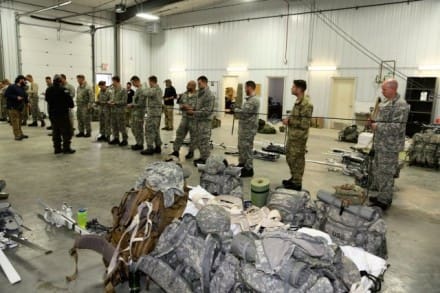
Soldiers who are students in the Fort McCoy Cold-Weather Operations Course learn about specialized knot-tying as part of course training Jan. 10, 2018, at Fort McCoy, Wis. (Photo Credit: U.S. Army photo by Scott Sturkol)
“This course gave me confidence,” said Staff Sgt. Joseph Chrysler with the 339th Psychological Operations Company of Arden Hills, Minnestoa, after completing Cold-Weather Operations Course Class 18-02. “It gave me confidence in my cold-weather clothing and gear and helped me (rebuild) skills that are not used every day in today’s Army … Also, some of the best parts of this course were learning to build a thermal shelter and (bivouacking) overnight in the elements.”
The course, also known as CWOC, is modeled on the Cold-Weather Leader Course taught by the Army Northern Warfare Training Center at Black Rapids, Alaska, said course instructor Bill Hamilton.
Hamilton said the course is designed to challenge students. “Our program of instruction includes overnight operations in the field,” he said. “We teach them a finite set of individual, leader, and small-unit collective tasks within a structured ‘crawl, walk, and run’ methodology.”
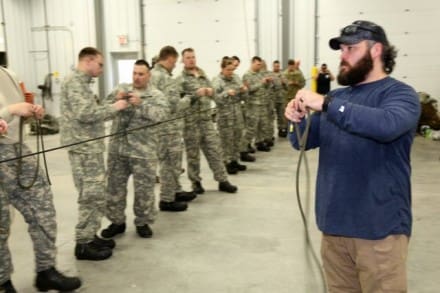
Instructor Hunter Heard with the Fort McCoy Cold-Weather Operations Course teaches Soldiers who are course students about specialized knot-tying as part of course training Jan. 10, 2018, at Fort McCoy, Wis. (Photo Credit: U.S. Army photo by Scott Sturkol)
Tasks taught include cold-weather injury identification and treatment, proper ways to wear cold weather clothing, cold weather risk management, snowshoeing and skiing, and adverse effects of cold weather on military equipment, Hamilton said.
Training also includes developing winter fighting positions in the field, camouflage and concealment, building improvised shelters, and numerous other areas that are important to know in order to survive and operate in a cold weather environment.
“We start off with classroom training for a few days and then it’s training in the field every day until we’re done,” Hamilton said. “In the field, the students spend time ruck marching for dozens of miles, skiing, snowshoeing, building tents and shelters, and more.”
Soldiers who are students in the Fort McCoy Cold-Weather Operations Course learn to ski and about skiing techniques Jan. 11, 2018, at Whitetail Ridge Ski Area at Fort McCoy, Wis. (Photo Credit: U.S. Army photo by Scott Sturkol)
After being exposed to the cold weather in the field, many students said understanding the Army Extreme Cold-Weather Clothing System, or ECWCS, was most helpful. The system, which is issued through the Fort McCoy Central Issue Facility, includes a lightweight undershirt and underwear, midweight shirt and underwear, fleece jacket, wind jacket, soft shell jacket and trousers, extreme cold/wet weather jacket and trousers, and extreme cold weather parka and trousers.
“You have to have confidence in your gear … It’s how you stay alive in extreme conditions,” said Staff Sgt. Anthony Steinhoff, who with the Wisconsin National Guard in Richland Center, Wisconsin. “In this course, they teach you how to properly dress for the cold.”
“Practical, hands-on application of using equipment seems to be one of the best ways for students to get familiar with the equipment needed to survive in cold weather,” Hamilton said.
Toward the end of the course, all students participated in cold water immersion training. Joe Ernst, also a CWOC instructor, said cold water immersion is critical to the ability to survive and operate in a cold weather environment.
“The experience of a service member being introduced to water in an extreme cold environment is a crucial task for waterborne operations and confidence building,” Ernst said. “For a person to fall into water in that environment, the onset of panic generally introduces itself quickly. For our service members who will be operating in an extreme cold environment, it is a task that, if not trained for, can produce unnecessary casualties.”
A Soldier participates in cold water immersion training at an ice-covered Big Sandy Lake as part of training for the Cold-Weather Operations Course 18-02 on Jan. 17, 2018, at Fort McCoy, Wis. (Photo Credit: U.S. Army photo by Scott Sturkol)
“The best parts of this course was learning to build an improvised shelter and the cold water immersion,” said Sgt. Hunter Carlson with the Wisconsin National Guard’s 1158th Transportation Company at Beloit, Wisconsin. “I didn’t enjoy doing either of them, but I realize how important learning those skills are and being able to use them.”
Army ROTC Cadet Molly Brown with the University of Wisconsin-La Crosse said she appreciated all of the training.
“Everything you need to know to succeed in (cold weather) is taught in this course,” Brown said. “This course significantly prepared me and taught me the skills needed to (operate) and survive in a cold weather environment.”
By Scott Sturkol and originally published at Army.mil.


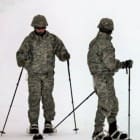
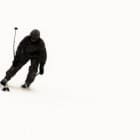
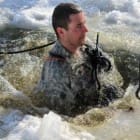
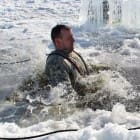
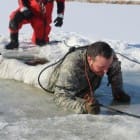
Great training. Probably more than a few people learning that the fuzzy top really wasn’t meant as a replacement for the coat, man’s, cold weather.
Does the US Army use heated shelters during winter ops? That’s what I see as the most critical for winter survival in the long run.
Yes. You pack up your akhio with an artic tent and Yukon stove. There are also newer ones called “Space Heater, Artic”. Don’t forget the cover for the diesel cans so your JP-8 doesn’t gel – hopefully.
I remember doing CWOC at black rapids (oddly warm when we did it at like 10 degrees). I think the instructor pictured was there when I went through. It was really good training and made life in general up there in the winter better outside of army things. Helped me in other units outside of Alaska planning winter training too. Even today, remembering skills I learned there to help raise my children in the winter (light layers and gloves!).
I don’t miss towing the akhios with snowshoes though.
Thanks! And thanks for sharing your great posts every week!